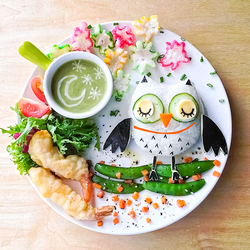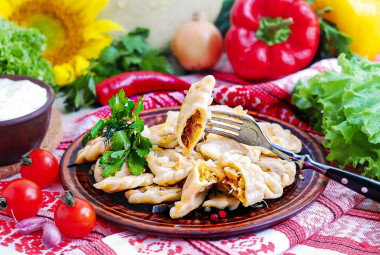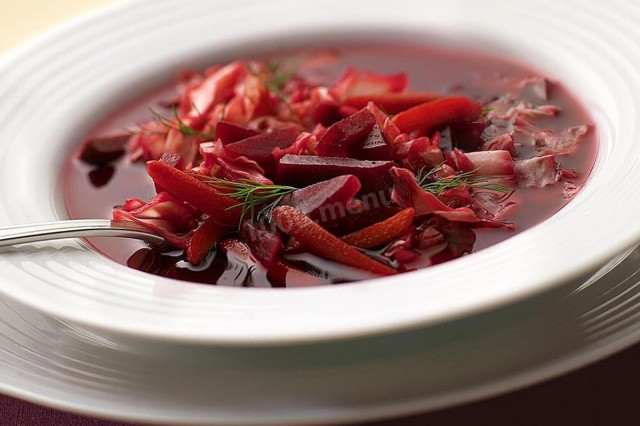Composition / ingredients
Step-by-step cooking
Step 1:
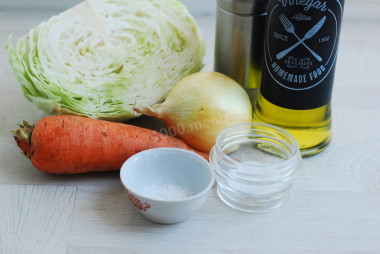
How to make dumplings with fresh cabbage? I recommend starting with the preparation of the filling, as it will take time to cool down. Prepare the ingredients according to the list. Take one large onion or two medium-sized ones. Peel the cabbage from the upper leaves, which are damaged and not usable (usually 2-3 leaves). Wash and dry with a paper towel.
Step 2:
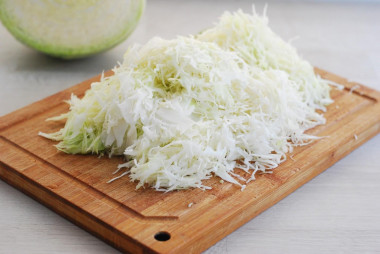
Chop the cabbage into thin strips and knead it a little with your hands. It will become softer and cook faster. Pour refined vegetable oil into a deep frying pan, heat it well. Lay out the cabbage. Fry for about 7-10 minutes on low heat under the lid until it becomes soft.
Step 3:

Wash and peel the carrots. Grate it on a coarse grater and send it to the cabbage. Stir and simmer under the lid for about 10 minutes.
Step 4:

Cut the peeled onion finely into cubes (the smaller it is cut, the tastier it will be). Add to the rest of the vegetables in the pan, mix. Simmer under the lid for another 10 minutes. Then add sugar, salt, ground black pepper. Simmer for another 5-7 minutes. Check the readiness of the cabbage on the thickest pieces. They should become soft. Transfer the finished filling to a suitable container and leave to cool.
Step 5:

While the filling is cooling, prepare the custard dough for dumplings. Prepare all the necessary ingredients. Use wheat flour of the highest grade, as the quality of dumplings depends on it. Sift the flour into a wide bowl or slide it onto the prepared work surface. Make a recess in the middle. Keep in mind that you may take more or less flour than I do. Focus on the consistency of the dough.
Step 6:

Wash the egg well with soda and wipe dry. Break it into a separate container, add a pinch of salt and a spoonful of odorless vegetable oil. Lightly shake the egg mixture with a fork. Pour into the flour, mix with a spoon. Carefully, so as not to get burned, pour in boiling water, actively kneading the dough with a spoon. Under the influence of hot water, gluten will quickly stand out in the dough and the dough will be smooth and elastic.
Step 7:
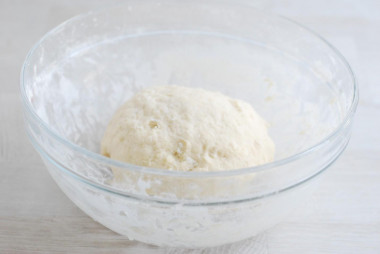
When the dough cools down, continue kneading the dough with your hands to feel its consistency better. The dough should be soft, not sticky. If necessary, add a little flour. Cover the container with the dough with a towel or film, leave to rest for 20-40 minutes. During this time, it will become very malleable and it will be easy to work with.
Step 8:

Work surface (I have a silicone mat), dust with flour. Put part of the dough on the work surface and knead well again. Roll it out to a thickness of several millimeters (about 4-5 mm). Using a suitable notch, squeeze the dough into circles.
Step 9:
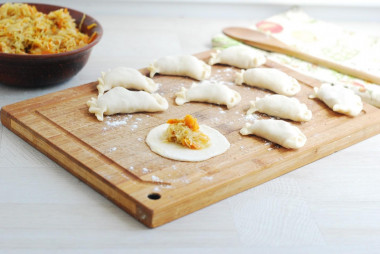
Put a teaspoon of filling on each circle in the middle. Make dumplings in the shape of a crescent. The edges can be sealed with a curly pigtail. Boil water in a large saucepan. There should be a lot of water so that the dumplings float freely and do not stick together. Salt it. Throw the dumplings into a saucepan with water, immediately mix them so that they do not stick to the bottom. When they boil, reduce the heat to low and cook for about 5 minutes.
Step 10:

Serve ready-made dumplings with butter, sour cream or fried onions. Enjoy your meal!
Onion frying is a lean option. If desired, you can also not coarsely chop the fat, fry it in a frying pan to melt the fat. Then add the onion and massage until soft and golden "tan".
Formed dumplings can be frozen. Put them on a cutting board, sprinkled with flour. It is important that they do not come into contact with each other. Send the products to the freezer for 1-2 hours. After that , pack them in bags with a zipper for further compact storage in the freezer .
Cooled boiled dumplings can be heated by frying in a frying pan until golden brown.
Use oil with a high smoking temperature for frying! Any oils are useful only until a certain temperature is reached - the point of smoking, at which the oil begins to burn and toxic substances, including carcinogens, are formed in it.
Unrefined oils, with rare exceptions, have a low smoking point. There are a lot of unfiltered organic particles in them, which quickly begin to burn.
Refined oils are more resistant to heating, and their smoking point is higher. If you are going to cook food in the oven, on a frying pan or grill, make sure that you use oil with a high smoking point. The most common of the oils with a high smoking point: refined varieties of sunflower, olive and grape.
You can check whether the oil has warmed up well enough in a frying pan in a simple way. Lower a wooden spatula into it. If bubbles have gathered around it, then you can start the frying process.
For cooking, it is better to use filtered or bottled water that is neutral to taste. If you use tap water, keep in mind that it can give the dish an unpleasant characteristic taste.
Caloric content of the products possible in the composition of the dish
- Carrots - 33 kcal/100g
- Dried carrots - 275 kcal/100g
- Boiled carrots - 25 kcal/100g
- Ground black pepper - 255 kcal/100g
- Granulated sugar - 398 kcal/100g
- Sugar - 398 kcal/100g
- Vegetable oil - 873 kcal/100g
- Salt - 0 kcal/100g
- Water - 0 kcal/100g
- Onion - 41 kcal/100g
- Wheat flour - 325 kcal/100g
- White cabbage - 28 kcal/100g
- Boiled white cabbage - 21 kcal/100g
- Chicken egg - 80 kcal/100g
